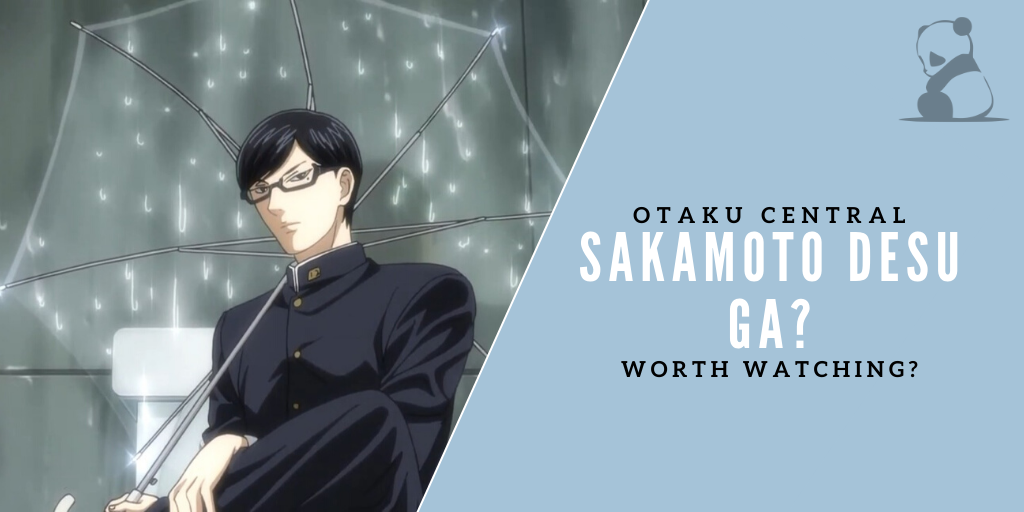
Is it worth? Who knows! I’ll let you decide, but first, you’ll need to give it a watch 🙂
Sakamoto is what happens when you take an observational approach to an overused trope, while also deciding to view it through a comedic lens. And in this case, the overused trope being examined is Mary Sue/Gary Stu characters. With portrayals that often border on the implausible due to the nature of these type of characters being flawless, Sakamoto purposely pushes pass the already thin threshold of practicality associated with them, to enter a realm beyond logic or reason. It exaggerates an archetype that’s already exaggerated, to begin with, resulting in what would usually be seen as idealistic features and feats in any other show, into laughter inducing comedic mishaps.

Any given episode sees Sakamoto modestly demonstrating his unparalleled COOLNESS in daily tasks at school and around his town, while also occasionally introducing other opposing characters that try to dethrone his position as the coolest character on campus. These naysayers often try desperately to outdo Sakamoto in some kind of task, only to have their plans backfire in their faces when his swag is proven to be too great for them to handle. Like everyone else that comes face to face with Sakamoto, they too are assimilated into the fold as one of his disciples, admiring his fabulousness from afar, while desperately seeking out his attention and approval.
The story structure of Sakamoto is similar to that of comedies like Cromartie High School, but where that over-exaggerates the actions of high school delinquents, Sakamoto switches its focus to idealized characters. And while it should go without saying that comedy is highly subjective, it’s still safe to say that if you like comedic stories with this kind of structure, then there’s a good chance that you would find Sakamoto’s offerings to be up to snuff. The protagonist’s deadpan delivery, coupled with the range of reactions given by his peers, is the selling point of the show. But with no other offerings besides this joke, it doesn’t take long for the misadventures of Swagmoto to border on lackluster. Like any other gag comedy with a central gimmick carrying it, there will come a point where the punchline doesn’t hit as hard as it did before, and Sakamoto wasn’t immune to this occurrence.
A joke that’s become par for the course runs the risk of growing dull. You could always spice it up with different scenarios, but when the core reasoning behind the joke remains the same, it ceases to deliver the same results after some time. This is usually why most comedy shows have something other than its signature style of humor to keep the viewer’s attentiveness. With a limited repertoire of comedic quips and material to worth with, Sakamoto often found its level of impact fluctuating on regular intervals. And while the scenarios are different, the jokes all center around the same comedic gag, which of course is Sakamoto’s unnervingly perfect execution of everything he does.
But even when the show doesn’t bring the laughs, you could still depend on Swagmoto to swoop in and save the day. If it doesn’t hit its target on the first try, there’s usually a follow-up attempt that does. This doesn’t mean that our messiah was always successful at salvaging a dying joke, but his efforts did keep the show from becoming a chore to watch. With Jesus on your side, anything is possible. Even a measly comedic attempt is still capable of making you smile when Swagmoto is behind it. The Lord is truly great and worthy to be praised.
Another key feature of Sakamoto’s sense of humor is just how upfront it is. It never feels mean-spirited about how it goes about masquerading any of these characters. Even when accounting for the fact that these type of characters presented are usually taken in a negative light. Mary Sue/Gary Stu characters are often detested by viewers, and rightfully so. Their presence usually indicates a sign of cheap writing on the creator’s behalf. So when Sakamoto views this detracting feature as a glass half full, it opens up an avenue for a new look on the subject.
Overall, while there may be certain parts throughout the Anime that may see dull to the average viewer, or to one that regularly watches Anime (as everything sooner or later seems to mesh together). It is enjoyable. If you wanted to watch something that stands out in a weird but enjoyable way, then Sakamoto Desu ga?, is an Anime you should give a watch on a day when you have nothing.
PREVIOUS BLOGS

BUY ME COFFEE!
A little can go a long way! Even a dollar is enough to motivation.
CA$1.00





2 responses to “Sakamoto Desu ga? | Worth Watching?”
I didn’t mind this one but ultimately found it got a little too repetitive. I ended up taking a fair break just after the mid-season before I slowly got back to finishing the final episodes. Still, individual moments in the series can be very funny.
I was struck by how much Sakamoto is a very Christian character: he always turns the other cheek, turns his enemies to friends with kindness, and so on. That doesn’t make your point wrong. In fact, he is totally Mary Sue, and if the series was longer it would be unbearable. But I was struck the the ethic he displays.